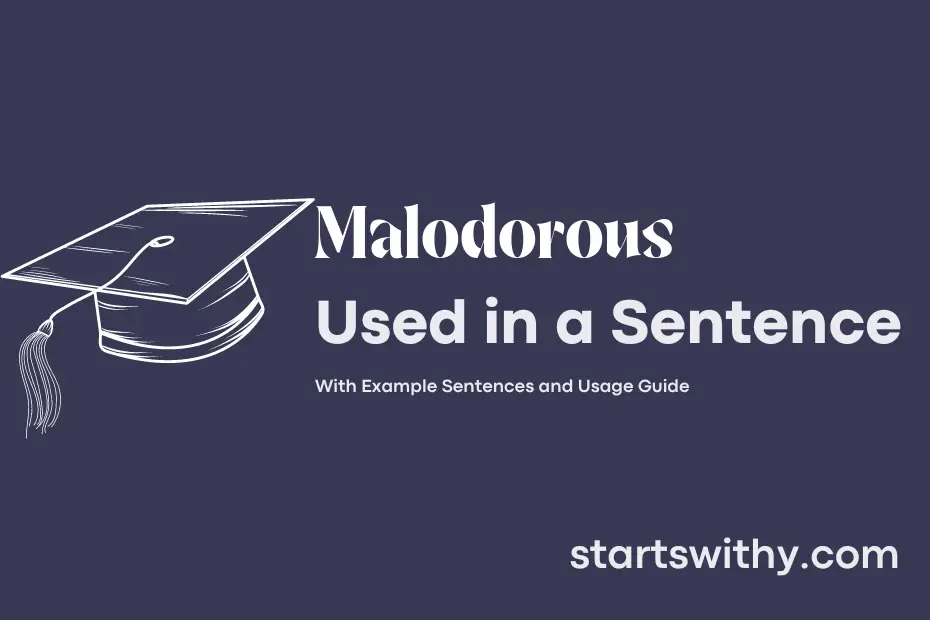Have you ever encountered a malodorous smell that made you wrinkle your nose in disgust? The term “malodorous” refers to a foul-smelling or unpleasant odor that can make one’s environment quite unpleasant.
These malodorous odors can come from a variety of sources such as rotten food, sewage, or even stagnant water. Despite their off-putting nature, they serve as a reminder of the importance of cleanliness and proper hygiene.
7 Examples Of Malodorous Used In a Sentence For Kids
- The malodorous garbage can needed to be emptied.
- The malodorous skunk sprayed a stinky smell.
- The malodorous socks needed to be washed.
- The malodorous trash made everyone cover their noses.
- The malodorous bathroom needed to be cleaned.
- The malodorous flower smelled very bad.
- The malodorous fruit was not good to eat.
14 Sentences with Malodorous Examples
- College students often complain about the malodorous bathrooms on campus.
- The refrigerator in the dorm room emitted a malodorous smell, indicating something had gone bad.
- After a late-night party, the common room was left in a malodorous state.
- The canteen’s cooking experiments sometimes resulted in malodorous dishes that students avoided.
- During monsoon season, the dampness in the hostel rooms led to a malodorous environment.
- The sports equipment locker room became increasingly malodorous as the weeks went by without proper cleaning.
- The abandoned classroom in the back building had a distinctly malodorous odor that made it off-limits for students.
- The chemistry lab occasionally had malodorous fumes escaping from experiments gone wrong.
- Students in the crowded library often had to endure the malodorous smell of unwashed clothes from all-night study sessions.
- The drains around the college campus emitted a malodorous stench that lingered in the air during hot days.
- The neglected trash cans near the lecture halls became a malodorous breeding ground for pests.
- The old textbooks in the library had a musty and malodorous smell that made students reluctant to borrow them.
- The gym changing rooms were always a malodorous mess, with sweaty clothes and unwashed towels strewn around.
- The abandoned corner of the campus was known for its malodorous odor, deterring students from exploring it further.
How To Use Malodorous in Sentences?
To use the word Malodorous in a sentence, you first need to understand its meaning. Malodorous is an adjective that describes something having a strong, unpleasant odor or smell. Here is a helpful guide on how to use Malodorous in a sentence for beginners:
- Identify a source of strong and unpleasant smell such as a garbage can, a dirty diaper, or spoiled food.
- Think of a sentence that describes the unpleasant smell using the word Malodorous.
- Construct a sentence that includes the source of the smell and the word Malodorous to convey the idea effectively.
- Make sure the sentence flows logically and grammatically.
For example: “The malodorous garbage can in the kitchen needed to be emptied immediately.”
In this sentence, the word Malodorous is used to convey that the garbage can in the kitchen has a strong and unpleasant smell. By following these steps, you can effectively incorporate the word Malodorous into your sentences to accurately describe things with bad odors. Practice using the word in different contexts to familiarize yourself with its usage and to enhance your vocabulary.
Conclusion
In conclusion, the examples of sentences with “malodorous” highlight how this term is used to describe foul or unpleasant smells. Whether it’s referring to a malodorous garbage dump, a malodorous gym locker room, or a malodorous old rug, the adjective paints a clear picture of something emitting a noxious odor. These sentences illustrate the importance of using descriptive language to accurately convey sensory experiences, such as unpleasant smells, to readers.
By incorporating “malodorous” into sentences, writers can evoke a visceral reaction from their audience, helping them to vividly imagine the offensive stench being described. This word adds depth and imagery to writing, effectively capturing the essence of foul odors and enhancing the overall sensory experience for readers.



